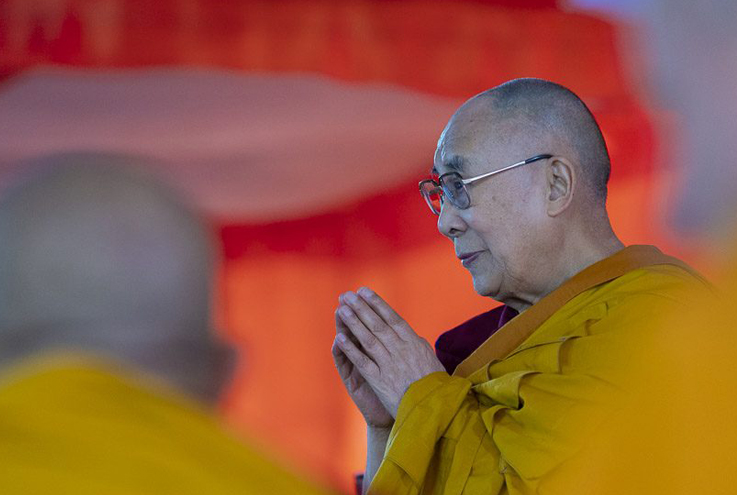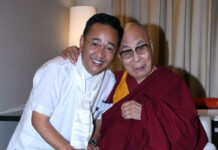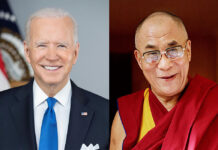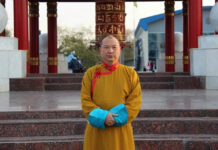
Rob Hogendoorn* points out how alleged sexual misbehaviour of a few Tibetan Buddhist masters based in the West is a legitimate concern with regard to the public image of Tibetan Buddhism and suggests that the Dalai Lama has led the way for other leaders to act on the issue.
(TibetanReview.net, Dec05, 2018) – Mere days before His Holiness the Dalai Lama’s visit to the Netherlands began on 14 September 2018, twelve survivors of sexually abusive Tibetan Buddhist lamas seized the opportunity of his pending visit. The survivors launched an online petition requesting the Dalai Lama to accept a collection of survivors’ testimonies in person—printrun: one, for his eyes only. The petition also asked him to respond to some of their ideas for follow-up action. To shield the twelve survivors from unwanted attention in (social) media, I acted as their liaison and press contact before and during the Dalai Lama’s visit. By the time he arrived in the port city of Rotterdam, over a thousand people worldwide had signed the petition. The Dalai Lama agreed to receive a delegation of these survivors on the day of his arrival—the announcement alone already made the international news.
While meeting the Dalai Lama in his hotel room, four survivors presented the booklet #MeTooGuru: Abuse survivors’ testimonies, for the Dalai Lama’s eyes only to him, along with more than 1,300 signatures and hundreds of declarations of votes in print. The petition is still available online (https://www.change.org/p/help-survivors-support-the-dalai-lama-s-effort-to-remedy-sexual-abuse). On 29 November 2018, it had been signed almost 2,500 times.
The survivors also handed the Dalai Lama investigative reports on alleged abuses within two of the largest Tibetan Buddhist organizations in the West. Counselling psychologist Andrea Winn’s ‘Buddhist Project Sunshine’ focusses exclusively on the alleged abuses within the Shambhala organization (formerly know as Vajradhatu) founded by Chögyam Trungpa. Winn disclosed three subsequent reports that were published online between April and August 2018. Lawyer Karen Baxter of the British firm Lewis Silkin investigated the allegations of abusive behaviour against Sogyal Lakar (formerly known as Sogyal Rinpoche) in a letter signed by eight former students and close collaborators. Her report was made public on 22 August 2018.
In the course of their conversation, the Dalai Lama agreed to the survivors’ other requests as well, inviting them to write an appeal to the religious heads of all major Tibetan traditions that would gather in Dharamsala on 29 November 2018. Unfortunately, this meeting had to be postponed due to the passing away of the recently appointed head of the Nyingma tradition, Kathok Getse Rinpoche.
The Dalai Lama’s meeting with survivors turned out to be epoch-making. News reports, interviews, and photographs appeared on the websites of Associated Press, The Washington Post, The New York Times, El País, and Süd-Deutsche Zeitung. The Dutch Eight O’Clock News and the BBC World Service broadcast their own reports. The Buddhist magazines Lion’s Roar and Tricycle published on the matter, as did large number of newspapers in the Dalai Lama’s adopted country India. The monthly Tibetan Review, much-read by exiled Tibetans and their Western supporters, was quick to pick up on the Dalai Lama’s endorsement of the appeal to the Tibetan hierarchs gathering in Dharamsala, headlining: ‘Top Tibetan Buddhist leaders to hear sex abuse allegations against lamas in the west?’
The next day, Nicole le Fever of Dutch public television network NOS asked the Dalai Lama what he had learned while meeting the survivors. His reply was startling: “I already knew these things, nothing new”. The Dalai Lama explained that he had been aware of allegations of sexual abuse against Sogyal Lakar ever since a Western Buddhists Teachers Conference was held in his residence in 1993. He recalled mentioning then that self-discipline and sexual ethics do not apply to monastics alone: “Buddha himself spoke about the lay practitioners’ sexual ethics as well”. Likewise, the Dalai Lama called to mind that he had stated then that the behaviour of repeat sex offenders must be made public, reiterating: “These people, they don’t care about Buddha’s teaching. So, now the only thing is: make public, these things. Then people may be concerned about their shame, their embarassment”. For this reason, he told the survivors in Rotterdam: “Now you make things clear. So, very good, I don’t care.”
The Dalai Lama’s forthright admission that he had known about sexual abuse for twenty-five years provoked new headlines: ‘Dalai Lama: I knew of sex abuse by Buddhist teachers since 1990s’; ‘Dalai Lama Admits to Knowing about Decades-long Abuse in Tibetan Buddhism’; ‘Dalai Lama says he knew about sexual abuse allegations made against Buddhist teachers’; and ‘Tibetan Buddhist Leaders Face “Me Too” Outrage’, to name a few. His follow-up remarks were mostly ignored by journalists and on social media. In hindsight, however, they seem even more pertinent and revealing.
Evidently, the abusive teacher the Dalai Lama had in mind during the conference in 1993 was Sogyal Lakar, who is a noncelibate lay teacher. While meeting the survivors, the Dalai Lama corroborated that he had been familiar with the allegations of sexual abuse against Sogyal Lakar since 1993. Karen Baxter has noted that the Dalai Lama received a ten page letter alleging such abuses in 1992—the very year he wrote his foreword to The Tibetan Book of Living and Dying. On 2 November 1994, a woman identified only as Janice Doe filed a complaint for damages against Sogyal and his international organization Rigpa. This case was settled out of court for an undisclosed sum. A contemporaneous news report cited the Dalai Lama’s secretary Tenzin Geyche Tethong as saying that Tibetan Buddhist leaders “have been aware of these (allegations) for some years now”.
On the Dalai Lama’s view, the excuse that a lama is not a monastic—and therefore not celibate—is fallacious. Why? Because the life of noncelibate Buddhist teachers ought to be curbed by self-discipline and morality too. Sogyal Lakar’s advocates, on the other hand, have argued that because he is noncelibate, he is entitled to following his own sexual preferences. All the same, the Dalai Lama does acknowledge that some lamas are incorrigible: the consequences of their intentions and actions—in short, their karma—and the damage that flagrant, undisguised transgressions cause to the public image of Tibetan Buddhism are no concern of them. Or, as he put it succinctly: “They don’t care about Buddha’s teaching.”
The Dalai Lama stopped just short of saying that lamas who do not care about Buddha’s teaching are not Buddhists. Tibetans have no word for Buddhist and non-Buddhist. Instead, they use chöpa for religious practitioner, and nangpa or chipa for insider or outsider. Chöpa or nangpa can be lay Buddhists and ordained Buddhist monastics, so Tibetan lamas can be celibate or noncelibate. The implication of the Dalai Lama’s observation is clear: he dissociates completely from repeat sexual offenders who do not take Buddhist morality serious enough to mend their ways. Reducing themselves to people who fear reputation damage more than the consequences of their own behaviour, they all but disown being Buddhist, effectively turning themselves into chipas or outsiders—and thereby become fair game for unwanted scrutiny by media.
As the present incumbent of his office, the Dalai Lama upholds three principal commitments: to preserve universal human values, religious harmony, and the religious and cultural heritage of the Tibetan people. Sexual and other abuses by Tibetan lamas subvert each of these objectives. Indeed, lamas who sexually assault Western followers in the name of Buddhism, hold the Tibetan heritage hostage—especially when they trample morality and ethics in its name in the full glare of publicity. In that case, Tibetan Buddhist leaders ought to protect Tibetan Buddhism’s public image. As the Dalai Lama told Nicole le Fever in closing: “Then also, you see, I mentioned, in the Winter, in November, all the important religious leaders of Tibetan traditions gather in Dharamsala. So, at that time, you see, they should appeal, I suggested. So, I think the religious leaders, I think, should pay more attention, like that”.
Thus, in one fell blow, by appealing to public support, the twelve abuse survivors turned their plight into a legitimate concern of the Dalai Lama and the Tibetan religious establishment. News reports on their meeting and on the abuse of many years within large Tibetan Buddhist organizations in the West soon reached the Tibetan community in exile. A Tibetan translation of the letter that prompted Sogyal Lakar’s resignation was sent to a large group of Tibetan (re)incarnations teaching in the West in November 2018.
Bearing in mind the abuse scandals that continue to haunt the Roman-Catholic church and the #MeToo movement focussed on public figures in the West, it requires no explanation that Tibetan hierarchs who stand by doing nothing will do so at their peril. The public image of Buddhism in the West is at stake, as well as that of the Tibetan community in exile. Against this background, the Dalai Lama’s parting remark to the survivors in Rotterdam sounds as a clarion call indicating that we might be on the cusp of a 21st century Tibetan Buddhist moral revival: “You have given me ammunition.”
——
* Rob Hogendoorn works as an investigative reporter and academic scholar. He has previously focused on philosophy of law from a Tibetan Buddhist perspective, and on the Mind & Life Dialogues between the Dalai Lama and (mostly) Western scientists: https://www.mdpi.com/2077-1444/5/3/522/htm. Over the past six years, he has focussed on sexual abuse by Buddhist teachers full time.






This guy Rob is a snake in the grass. I’ve seen him criticize His Holiness online many many times. He using His Holiness to push his ‘work’ forward, but in reality has no love for HHDL or Tibetan Buddhism. Mark my words, you’ll see how right I am. So be warned about this snake in the grass, because he will bite HHDL once he has used him to reach a bigger audiance.
I completely agree with you.
Mary Finnegan teamed up with this guy and they are happy to work together for a purpose. But she knows what he’s like – totally against TB and she’s willing to play along to suit her own need.
She knows he despises her beliefs in TB.
She’ll get bit too as you say.
Anyone can see through this guy Rob unless you’ve been having too many soya lattes
btw, I’m not Mary Finnegan, it’s Fogarty. Just incase!!
hogendoorn isn’t very professional as a journalist but he is exposing truth that others are ignoring. when people like mary f start name calling such as “snake in the grass” you know they have no facts to support their positions, but have only defamatory remarks.
the dalai lam did tell people ot to go to trungpa back in the eighties but not nearly forcefully enough and the same with sogyal. many kagyu engaged in similar sex abuse but were more low key. unfortunatly most of these tibetan cults are secretive to the point of being dangerous for vunerable people, and the members will not warn others of the dangers.